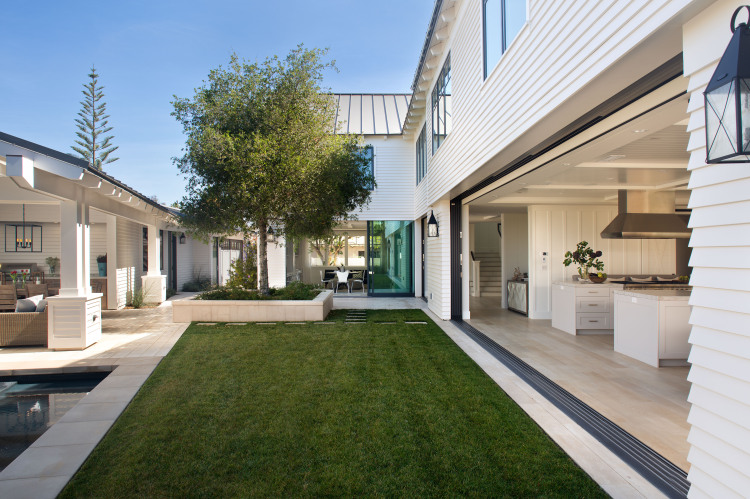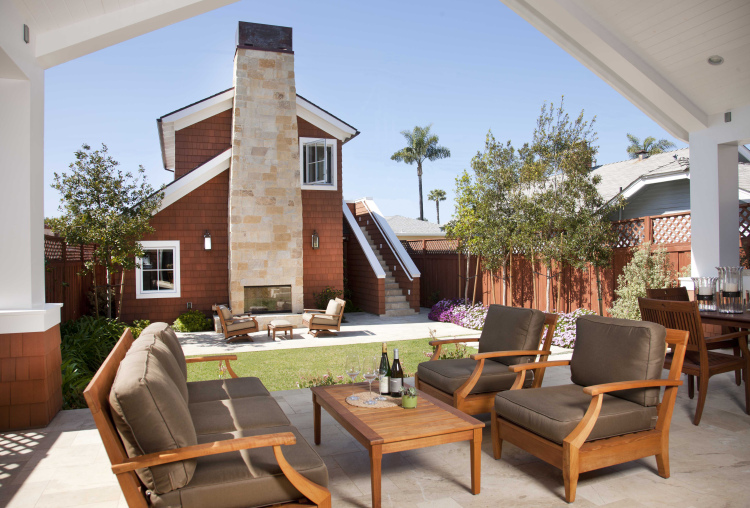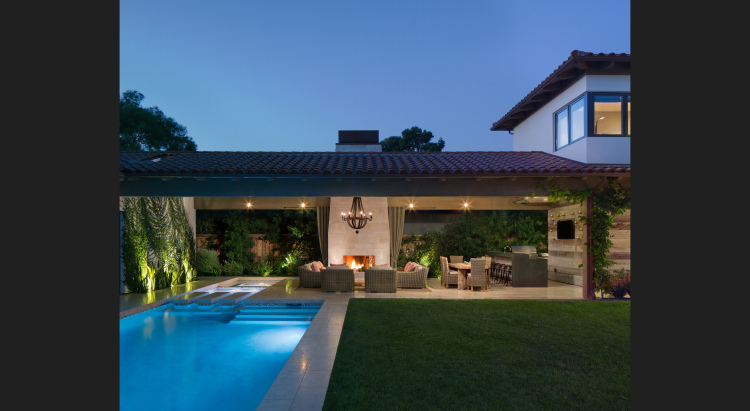
This home on Alameda Boulevard designed by Christian Rice, AIA, features an interior courtyard created by the main home and a detached guest house with an outdoor living room.
This is the second article about the views of Coronado architects. The first article, with Architect Dorothy Howard AIA, provided Howard’s insights and opinions regarding residential, commercial and public architecture in Coronado and her assessment of what Coronado will be like in 10 years. Following are the responses from architect Christian Rice, AIA to the same questions.
Rice received a Master of Architecture degree from Arizona State University and holds a bachelors degree in economics from the University of California in Berkeley. He established his practice in Coronado in 2004, prior to that he worked for several architectural firms in Atlanta, Phoenix, and Los Angeles.
During the time that you have been practicing in Coronado what are the biggest changes, if any, that you have observed in your clients?
Greater diversity of clients- which I believe speaks to the expanded reach of Coronado as a city and destination. Ten years ago, my clients were typically primary homeowners or possibly vacation buyers from Arizona. Now I am seeing buyers from throughout the country- as far away as Georgia, Florida, and the east coast as well as international – Mexico and France to name a couple.
During the time that you have been practicing in Coronado how do you think changes in lifestyle have influenced the design of Coronado houses?
Somewhat – although since I started my company about 10 years ago- the open concept of living – namely the great room, has continued to dominate most floor plans. The desire for outdoor living rooms has increased. Many vacation buyers are interested in a maximum number of bedrooms – and like the concept of bunk rooms as well for kids. Home technology and green building technologies continue to advance as well, including more frequent installation of solar panels for electricity generation, home technology systems, and higher efficiency heating and cooling systems among other advances. I think grey water recycling systems will become more prevalent in the next ten years as well.
(Editorial Note: Greywater is waste water from laundry appliances, showers, dishwashers and sinks. (Black water is the waste water from toilets.) Greywater recycling systems use the waste water to irrigate landscaping. A greywater recycling system is a standard feature in a new residential development in Rancho Penasquitos. The recycling along with water saving fixtures and appliances should reduce daily water use per resident by 72 percent compared to typical usage.)
 In this residence designed by Rice, a fireplace and stone chimney on a detached carriage house creates a unique visual focal point.
In this residence designed by Rice, a fireplace and stone chimney on a detached carriage house creates a unique visual focal point.
What are some of the unique challenges that an architect faces when designing a residence in Coronado? How do you respond to these challenges?
Size constraints would be biggest challenge. Lots are small – and very expensive relative to the size, but people still need a certain amount of space to live comfortably with their families. For this reason, the prevalence of basements has increased to provide much needed additional living area and flexibility with the floor plan
Do you think that the quality of the residential architecture in Coronado is improving, is remaining essentially unchanged, or is deteriorating? What is the basis for your opinion?
Similar to when I started my company, there were/are a handful of architects, developers, and design/build teams building what I consider to be thoughtful, well designed homes. There is certainly a segment of our industry that is building less-thoughtful designs, but this seems to have been present ten years ago as well.
What could be done to improve the quality of the residential architecture in Coronado, if anything?
I think it is very important to hire a licensed architect for any new home design or even any residential remodeling. Architects are trained in all aspects of design – and are well suited to tackle the challenges associated with working in Coronado. I would argue that it takes even more creativity and skill to artfully design a home for our relatively small Coronado properties. A family’s home is typically their single largest financial investment – which is most likely true for the majority of Coronado homeowners. While an architect may cost more up front, I think the investment more than pays for itself through greater functionality, aesthetics, and most certainly, ultimate resale value. You wouldn’t put bargain tires on a luxury automobile, so why do the same with your valuable Coronado property? I believe that the quality of residential architecture would be improved if more architects are hired to work on homes in Coronado.
(Editorial Note: In California residences do not need to be designed by architects. Coronado encourages the use of architects by allowing an increase in the Floor Area Ration (FAR), if a licensed architect is used to design a residence.)
 In the design of this residence Rice integrates a covered outdoor living room with a pool and outdoor kitchen.
In the design of this residence Rice integrates a covered outdoor living room with a pool and outdoor kitchen.
How would you describe the commercial architecture in Coronado and the overall appearance of the citys business district?
I think our commercial district is as varied as our residential areas – with an eclectic mix of architectural styles.
What could be done by the city to improve the appearance of the citys business district?
All new commercial buildings, façade renovations/remodels, and new signage are reviewed by the Coronado Design Review Commission. The city created the Orange Avenue Corridor Specific Plan Zone a few years ago, which gives very detailed guidelines for what is allowed in our business districts. The city monitors all new work in the business districts about as closely as possible in my opinion.
How would you describe the quality and appropriateness of the public architecture in Coronado including the police station, library, schools, Community Center and City Hall?
I think the recent public works projects have been excellent in design and quality. I think they are a great fit for Coronado and our coastal locale.
Increased density is often cited as a problem in Coronado along with the loss of the citys village atmosphere. What do you think is the greatest contributor to this sense of increased density?
I think what is happening is that many streets in Coronado are actually being built-out to the extent that it is easy for people to see what has been allowed in the zoning ordinance for many years. Now that people are seeing 50% or more of the homes on some streets being expanded and rebuilt to what zoning allows, they are getting an understanding of the actual density that the city allows – and has allowed for many years. Many areas in town are zoned to be very dense – urban living really. The small cottages that existed in these areas for so many years were ill-representative of what was allowable in the code.
What could be done to counter it?
The city is constantly updating the zoning code – and this is happening again right now. I think this will help, but I also think a large part of what creates the village atmosphere is good design, which is not always present in new construction – which feeds back into the importance of hiring an architect for your design needs.
In ten years what do you think Coronado will be like and why?
I think more and more streets will be built-out to represent what is allowed by the zoning code. I think this will be most noticeable in the multi-family R-3 zones and the Country Club Estates areas of Coronado. There will certainly continue to be construction activity in the others areas of town as well, I just dont think the changes will be that noticeable. It is fairly easy to drive down streets in Coronado and point out homes that will most likely be demolished and rebuilt when they sell. This should give residents a good idea of how much their street may change in the next ten to twenty years.
Additionally, in the R-3 zone, the amount of apartments for rent will continue to decrease. The zoning code makes it very difficult – almost impossible – to make new apartment developments viable in Coronado due to the amount of dwellings allowed per lot and parking requirements per dwelling. The trend of demolishing apartment buildings and replacing them with for-sale condominiums will continue.
A portfolio of Rices work is available on his website at http://christianrice.com/.
—
Related: Views of Coronado – Architect Dorothy Howard AIA: In 10 Years, More Dense, Less “Home Town” (read article)
John Tato
Staff Writer




